- Alvin Kamara remains a focal point: Kamara’s efficiency has dropped in the last four seasons relative to his first four seasons, but that hasn’t stopped him from consistently being among the league leaders in touches each season.
- New head coach Kellen Moore could limit Kamara: Kamara’s best efficiency stats are in the pass game, but Moore has a consistent history of not prioritizing running backs in the passing game, despite having very good receiving backs in the past.
- Subscribe to PFF+: Get access to player grades, PFF Premium Stats, fantasy football rankings, all of the PFF fantasy draft research tools and more!
Estimated Reading Time: 5 minutes

PFF’s Fantasy Football Player Profile series delivers the most in-depth fantasy football analysis available for the 2025 season.
Using PFF’s exclusive data, we evaluate player performance, competition for touches and how teammates and coaching staffs will impact each player’s fantasy football outlook.
Last updated: 7:15 a.m. Sunday, May 18
Player performance
Kamara was drafted in 2017 and instantly turned into fantasy gold due to his receiving ability. He finished fourth in fantasy points per game as a rookie despite only running the ball 120 times. He followed that up by finishing fourth again, eighth and first. He averaged 4.6 yards per carry or better in all four seasons and caught between 81-83 passes.
In 2021, the Saints shifted Kamara to more of a rusher and less of a receiver. He ran 240 times, 46 more than his previous career high, but only caught 47 passes. He averaged 3.7 yards per carry. He finished sixth in the league in rushing attempts and ninth in receptions, still allowing him to finish sixth in fantasy points per game.
Kamara’s grades never returned to his pre-2020 levels, where he reached an 82.0 offensive grade or better in three of his first four seasons and under 75.0 in each of the last four. However, his volume has remained strong. He’s averaged at least 15 carries per game over the last three seasons and 4.7 receptions per game. He’s missed a few games every season, but he still ranks 10th in rushing attempts and first in receptions over the last three seasons. His 85.3 rushing grade over the last three seasons is 25th among the 71 running backs with at least 500 snaps, while his 74.0 receiving grade is 16th. His yards per carry in every situation have been below average over these three seasons.
A big reason he’s been able to maintain elite volume with only good to average efficiency is a lack of competition for touches. His primary competition has been tight end Taysom Hill, Mark Ingram II at ages 32 and 33, the often injured Kendre Miller, and Jamaal Williams in addition Tony Jones, who are both unsigned free agents.
Kamara’s fantasy value increased last season with more carries per game, largely thanks to injuries to Derek Carr, Chris Olave and Rashid Shaheed, leading the team to rely on Kamara as the primary healthy option of the offense.
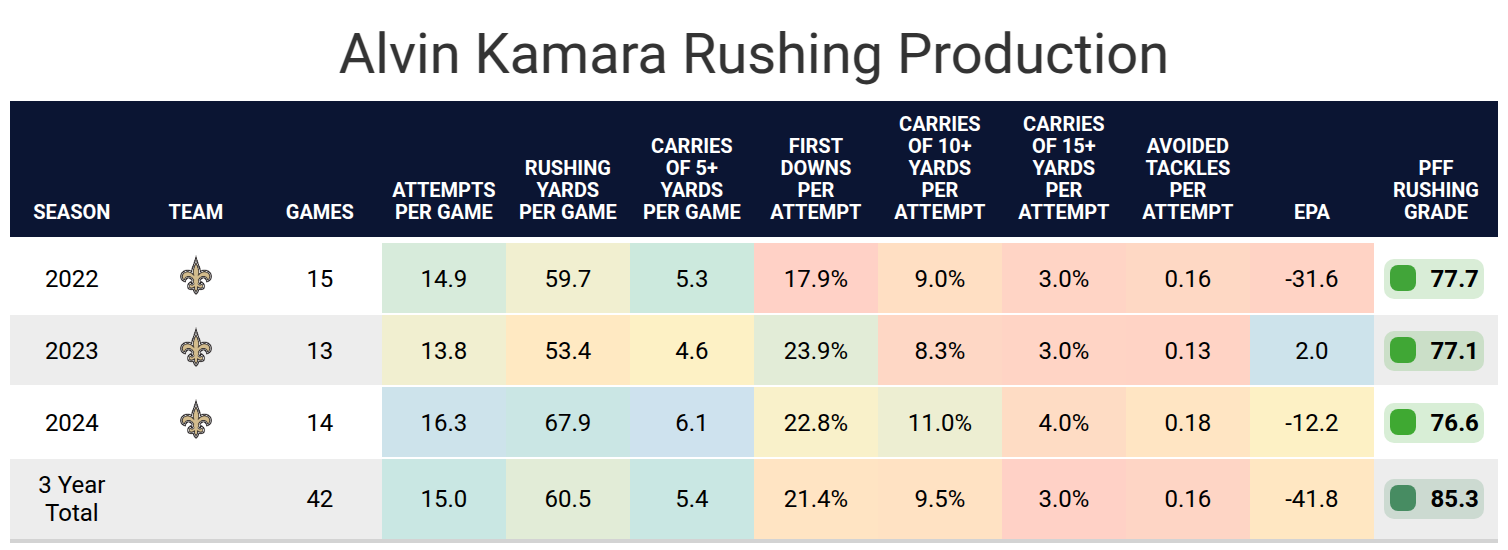
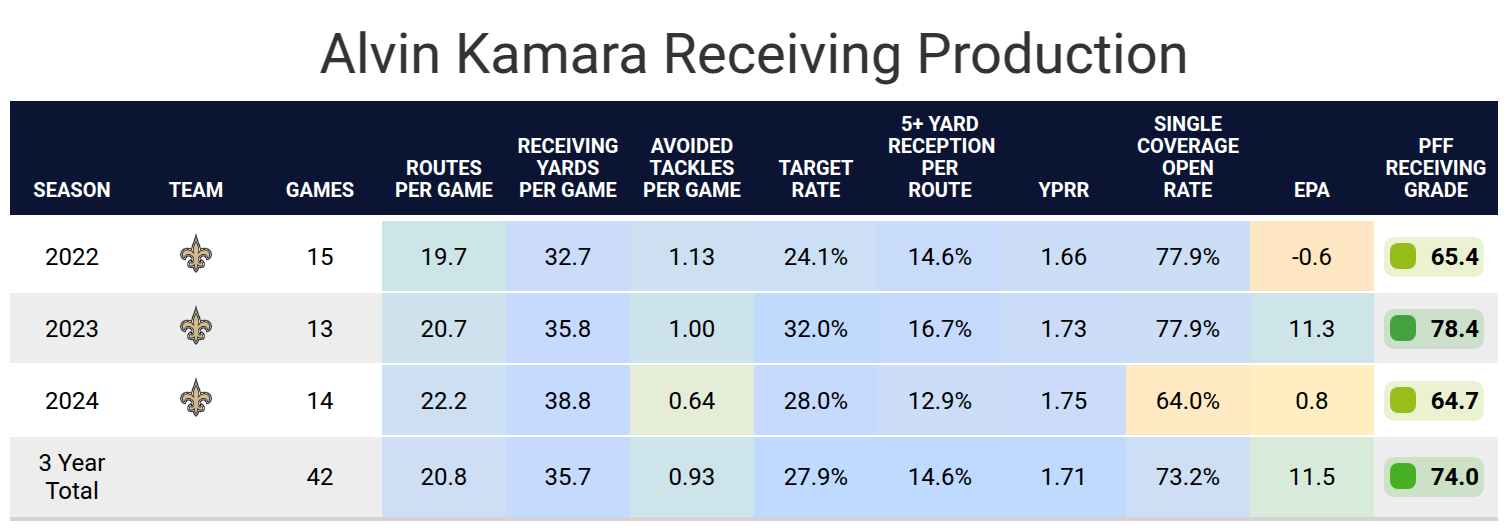
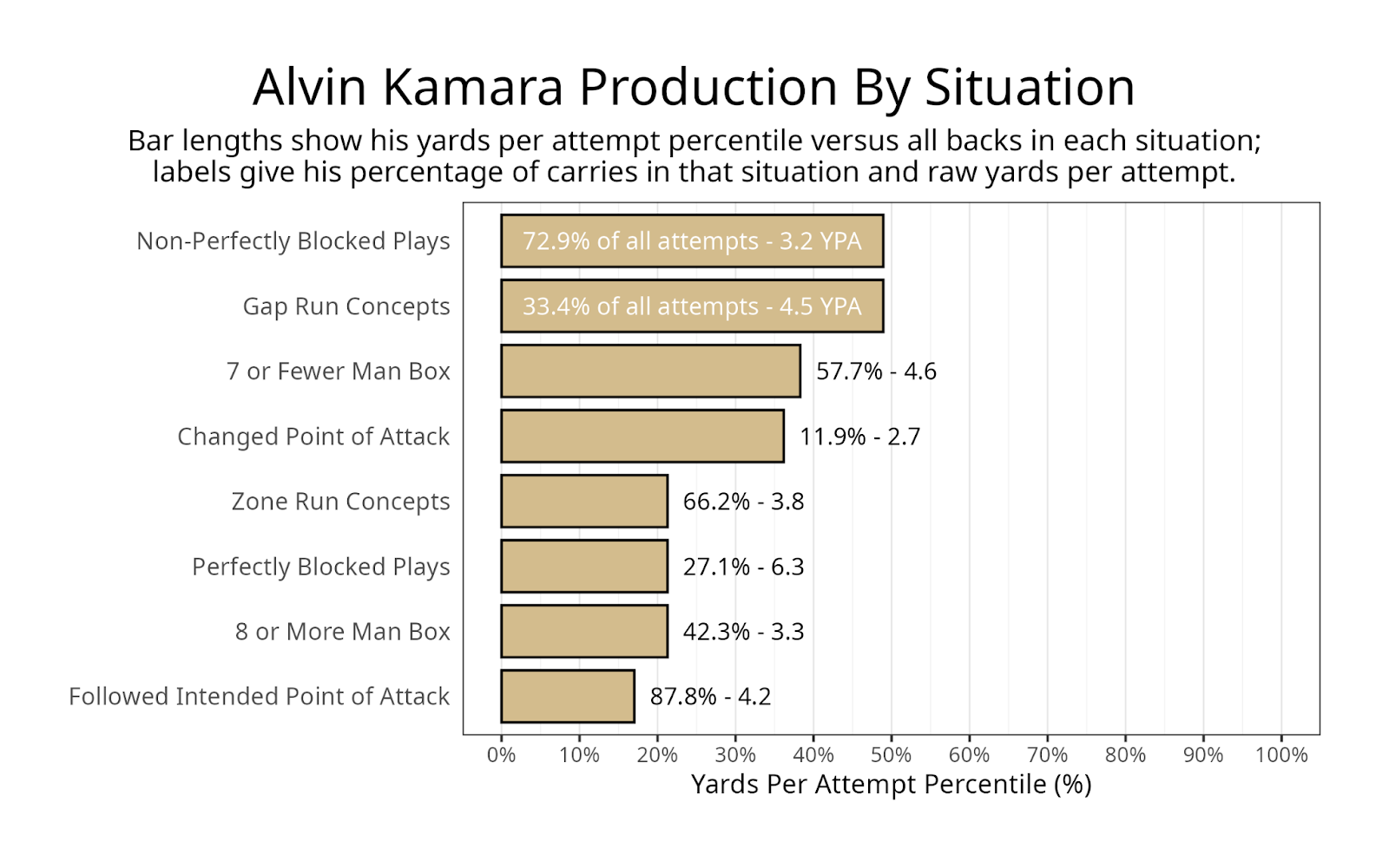
Projected role
Kamara could have more competition for snaps and touches this season. There were only a few games where Kamara and Kendre Miller shared the backfield, but in the first two, Kamara was limited to a 57% snap rate. In the third game they played together, Miller was limited coming back from injury, and in the final game they shared the field; Kamara suffered an injury. Considering Kamara will be 30 years old and Miller will be 23 by the time the season starts, it wouldn’t be surprising if Miller can cut into Kamara’s playing time.
The team added Devin Neal in the draft, and he is also someone who could carve out a role in the offense. New head coach Kellen Moore called Kamara “a premier player in our league” when asked about Kamara but also said “he’s just a big play waiting to happen,” which hasn’t necessarily been true the last few seasons after it was very true early in his career. Moore ended, “He’ll be a big part of our offense.” This makes Kamara’s role relatively safe at least early in the season, but there is a chance that ineffective play could open the door for a younger back.
Regardless, we could see his touches per snap decrease by a few percentage points this season. It shot up last year after the injuries to most of the other skill players in the offense. Derek Carr‘s retirement will likely leave the Saints as a run-heavy team, but the return of the wide receivers should leave them passing more than they were at times last season.

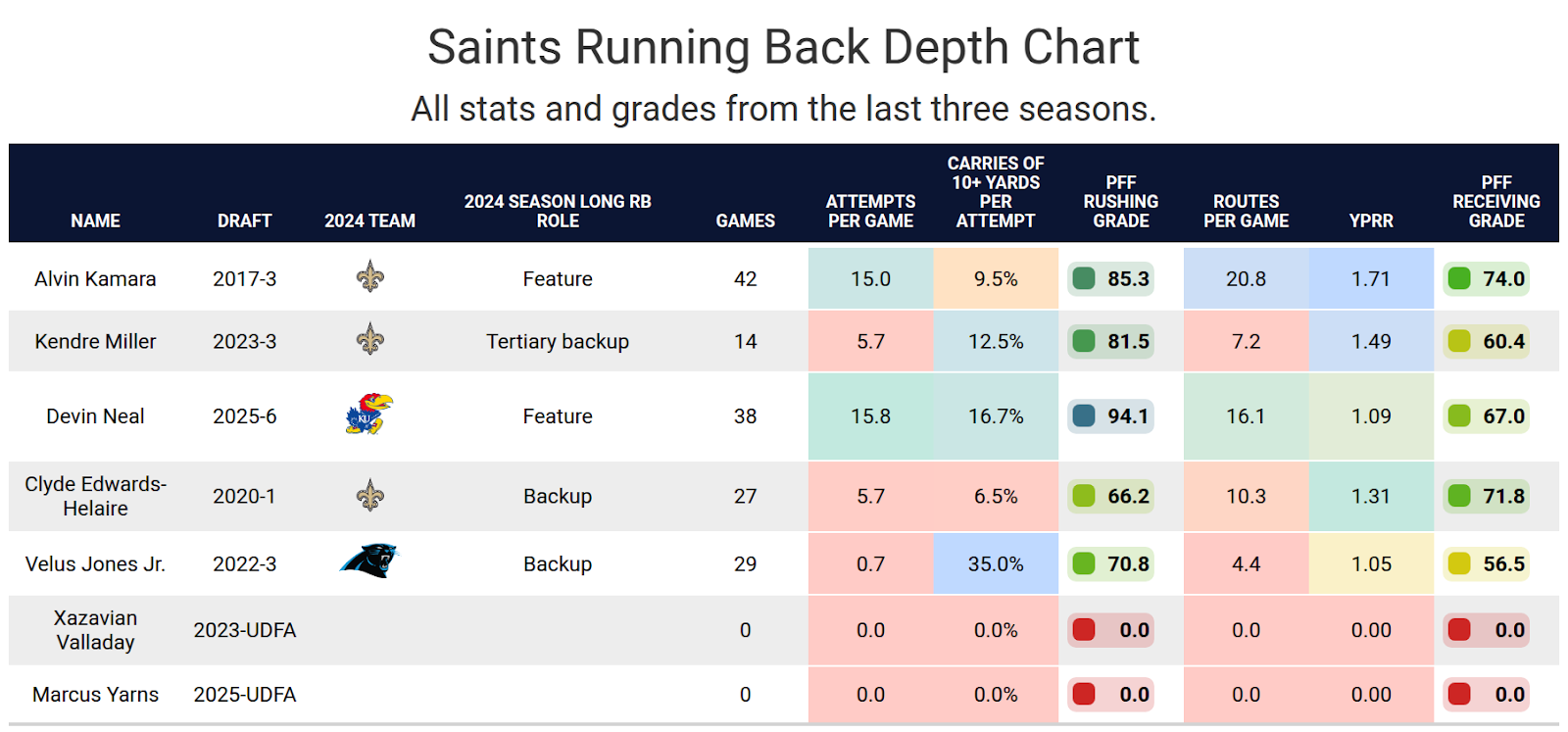
Impact of teammates
Kamara has Moore as a head coach, who has constantly had a high plays per game, which is promising. His run rate over expected has varied, which leads to the idea that the Saints will be more run-heavy like his Dallas Cowboys and Philadelphia Eagles teams. The one concern with Moore is the low running back target rate. Saquon Barkley had a 17.7% or better target rate every season with the New York Giants, but that fell to 13.8% with the Eagles. Austin Ekeler had a career low in yards per route run at 1.25. Ezekiel Elliott was consistently above 1.0 yards per route run, and once Kellen Moore took over, his yards per route run dropped below 1.0, just to exceed 1.0 again in his first season without Moore. While Kamara should be the clear leader running the ball, we could see a notable dip in his receiving production.
The Saints had a top-10 run-blocking offensive line last season because the team constantly prioritized the line from the NFL draft. Center Erik McCoy was a clear strong point with an elite 94.6 run-blocking grade, but he was only able to play seven games. The team moved on from their oldest veteran, Lucas Patrick, in favor of Kelvin Banks Jr., New Orleans’ first-round rookie. Considering all of the injuries to the interior parts of the line, there is a chance the line could rank even higher than the top 10 this season.
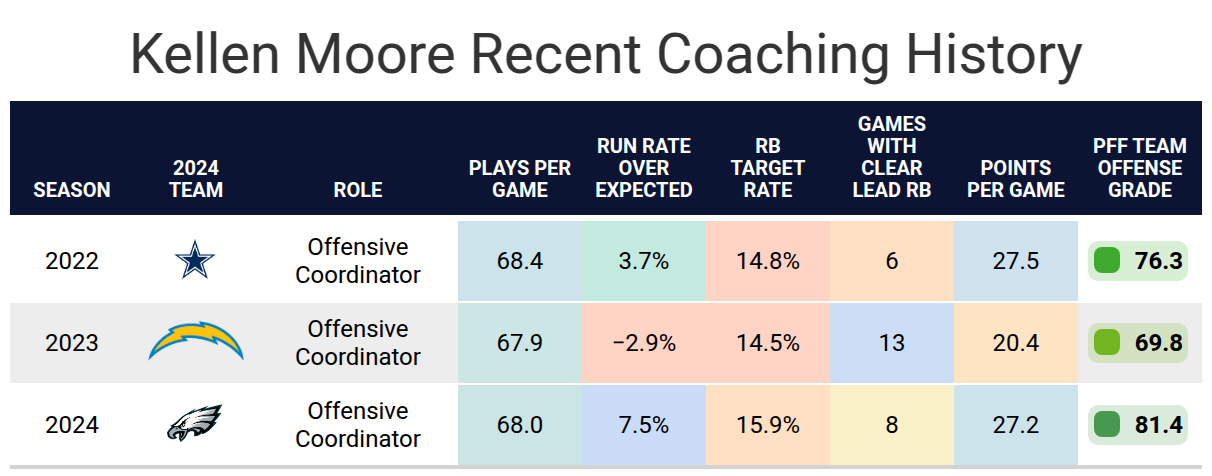
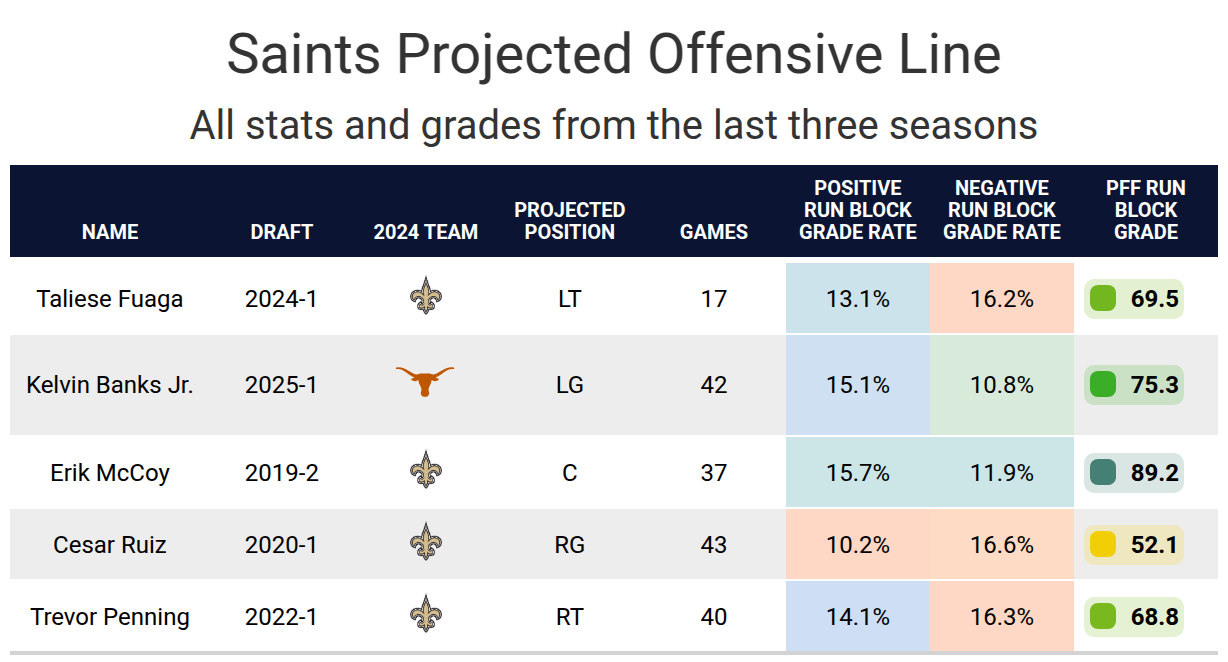
Bottom line
Kamara finished fifth in the fantasy points per game last season. That is bound to drop at least a little bit due to Moore’s history of not using running backs much in the passing game even when they’ve been great receivers and his age. There is also at least a risk that the new coaching staff and healthy younger running backs will lead Kamara to receive fewer carries. While his upside is limited, he’s also safer than a lot of other running backs with an ADP between 11-20.

Footnotes
- Statistics in tables and charts were chosen based on their ability to predict future fantasy performance on a per-game or per-opportunity basis or to describe the player relative to others at the same position.
- “Opportunities” are defined as passing dropbacks, rushing attempts and routes run as a receiver.
- Numbers are provided either by season or based on the past three years. For rookies, only college statistics are included. For non-rookies, only NFL statistics are considered, regardless of whether they played in college within the previous three years.
- As college competition is easier than NFL competition, most rookies are likely to see a decline from their historical numbers.
- Only FBS data is considered for college players and comparisons.
- Kneel-downs are removed from rushing data to provide cleaner quarterback rushing rate statistics.
- The table colors in this article range from blue (indicating good/high) to red (indicating bad/low).
- All percentiles and color codings compare the given player to others with a high sample of opportunities. Generally, the cutoff is one-third of the possible opportunities in the sample. If a player does not meet the threshold, they are still included in the comparison, though their results may appear better or worse than expected due to the smaller, less predictive sample size.
- Information on utilization classifications and their importance can be found here for running backs, wide receivers and tight ends.
This news was originally published on this post .








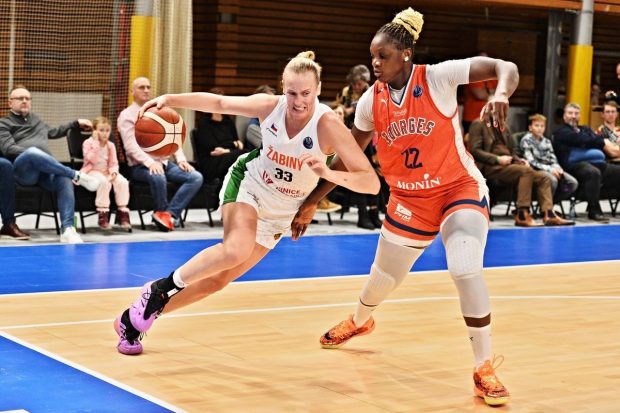
Be the first to leave a comment